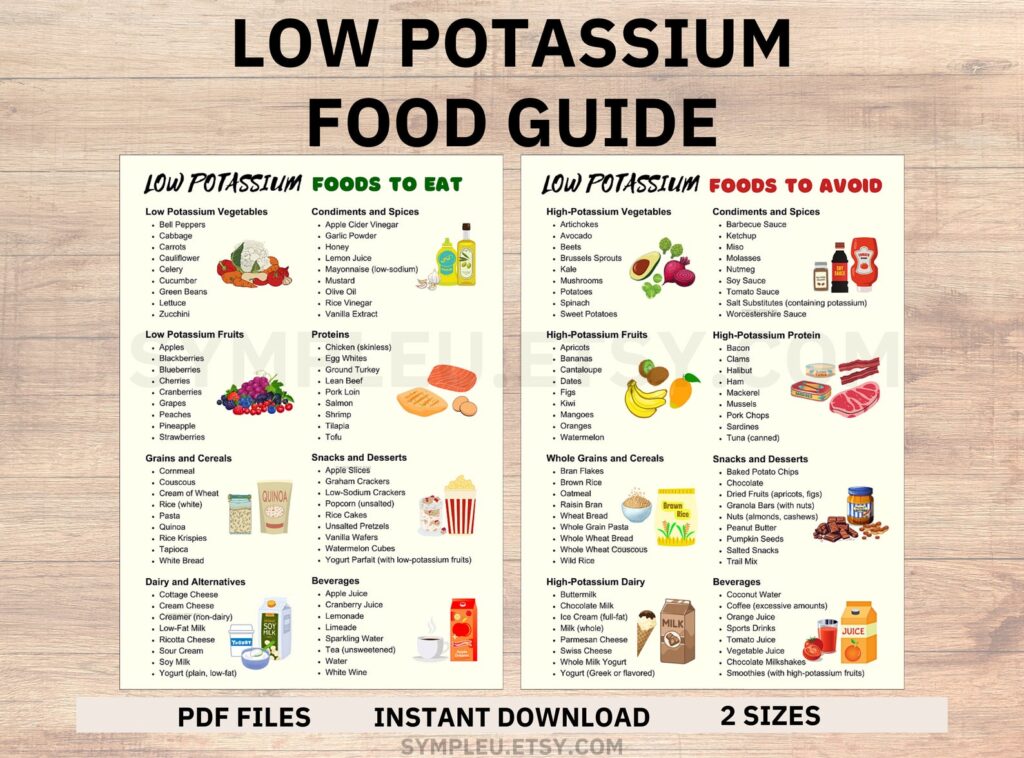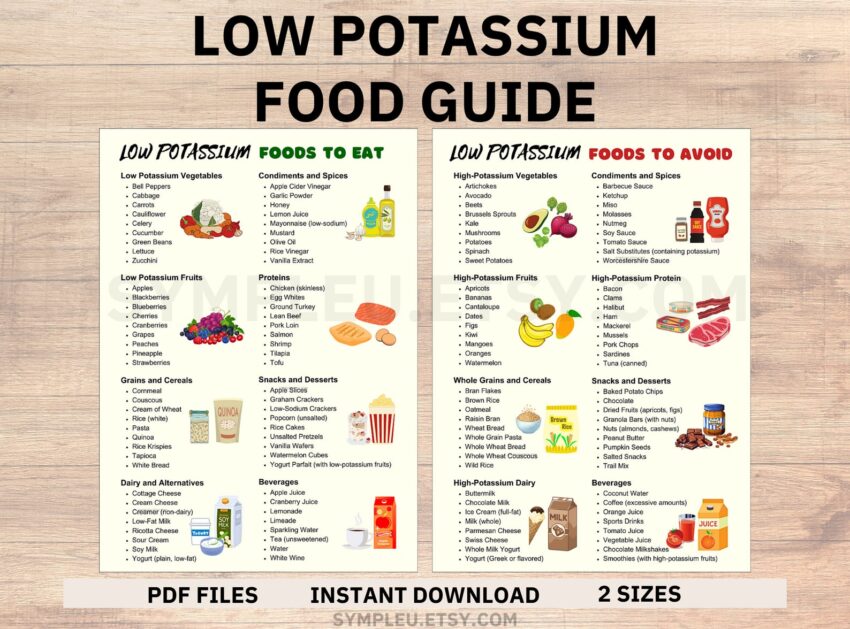
Navigating Nutrition: A Guide to Low Potassium Phosphorus Foods
Managing kidney health often involves dietary adjustments, particularly focusing on potassium and phosphorus intake. For individuals with chronic kidney disease (CKD) or those undergoing dialysis, understanding which foods are low in these minerals is crucial for maintaining overall well-being. This comprehensive guide explores the landscape of low potassium phosphorus foods, providing practical advice and insights to help you make informed dietary choices. We’ll delve into specific food categories, offering examples and tips for meal planning that supports kidney health.
Understanding Potassium and Phosphorus in Kidney Health
Potassium and phosphorus are essential minerals that play vital roles in various bodily functions. Potassium helps regulate heart rhythm, muscle contractions, and nerve signals. Phosphorus is crucial for bone health, energy production, and cell repair. However, when kidneys aren’t functioning optimally, these minerals can accumulate in the blood, leading to serious health complications.
High potassium levels, known as hyperkalemia, can cause muscle weakness, heart arrhythmias, and even cardiac arrest. Elevated phosphorus levels, or hyperphosphatemia, can lead to bone disease, calcification of soft tissues, and increased risk of cardiovascular events. Therefore, managing potassium and phosphorus intake is a cornerstone of kidney disease management.
Fruits: Delicious and Kidney-Friendly Options
Many fruits can be incorporated into a low potassium phosphorus diet. However, portion control is key to maintaining healthy mineral levels.
- Apples: A versatile fruit that can be enjoyed raw, baked, or as applesauce.
- Berries: Strawberries, blueberries, and cranberries are excellent choices, packed with antioxidants and relatively low in potassium and phosphorus.
- Grapes: Red and green grapes offer a sweet treat without excessive mineral content.
- Pears: A good source of fiber and vitamin C, making them a healthy addition to your diet.
- Pineapple: Provides a tropical flavor and contains bromelain, an enzyme with anti-inflammatory properties.
- Watermelon: Refreshing and hydrating, but consume in moderation due to its potassium content compared to other fruits on this list.
It’s important to note that certain fruits, such as bananas, oranges, avocados, and dried fruits, are high in potassium and should be limited or avoided on a low potassium phosphorus diet. Always consult with a registered dietitian or healthcare professional to determine the appropriate fruit choices and portion sizes for your individual needs.
Vegetables: Nutrient-Rich Choices for Kidney Health
Vegetables are an essential part of a balanced diet, providing vitamins, minerals, and fiber. When following a low potassium phosphorus diet, selecting the right vegetables is crucial.
- Cabbage: A versatile vegetable that can be used in salads, slaws, and cooked dishes.
- Cauliflower: A cruciferous vegetable that’s low in potassium and phosphorus and can be steamed, roasted, or mashed.
- Green Beans: A good source of fiber and vitamins, green beans are a kidney-friendly choice.
- Onions: Adds flavor to dishes and is relatively low in potassium and phosphorus.
- Peppers: Bell peppers (especially red and yellow) are packed with vitamins and antioxidants.
- Radishes: A crunchy and peppery root vegetable that can be added to salads or eaten as a snack.
- Turnips: A root vegetable that can be boiled, mashed, or roasted.
Some vegetables, such as potatoes, spinach, tomatoes, and beans, are high in potassium and phosphorus and should be consumed in moderation or avoided on a low potassium phosphorus diet. Leaching potatoes by boiling them in water can help reduce their potassium content, but this method should be discussed with your healthcare provider before implementation. [See also: How to Leach Potassium from Potatoes]
Protein Sources: Making Smart Choices
Protein is essential for building and repairing tissues, but some protein sources are higher in phosphorus than others. Choosing low potassium phosphorus foods within the protein category is important for kidney health.
- Egg Whites: A good source of protein with minimal phosphorus.
- Skinless Chicken Breast: A lean protein option that is relatively low in phosphorus.
- Fish: Certain types of fish, such as cod and tuna (canned in water), are lower in phosphorus than others. Limit portion sizes.
- Lean Beef: Choose lean cuts of beef and limit portion sizes.
Processed meats, such as bacon, sausage, and deli meats, are often high in phosphorus and sodium and should be avoided. Dairy products are also generally high in phosphorus. Plant-based protein sources like lentils and beans tend to be higher in both potassium and phosphorus, so moderation is key. [See also: Plant-Based Protein and Kidney Disease]
Grains and Starches: Selecting the Right Options
Grains and starches provide energy and fiber. When choosing low potassium phosphorus foods in this category, consider the following:
- White Rice: A good alternative to brown rice, which is higher in phosphorus.
- White Bread: Choose white bread over whole-wheat bread, as whole grains tend to be higher in potassium and phosphorus.
- Cornstarch: Can be used as a thickening agent in sauces and gravies.
- Pasta: Choose white pasta over whole-wheat pasta.
- Cream of Wheat: A warm cereal option that is lower in potassium and phosphorus compared to other cereals.
Whole grains, such as brown rice, whole-wheat bread, and oatmeal, are generally higher in potassium and phosphorus. Read labels carefully and choose products that are lower in these minerals. [See also: Kidney-Friendly Grain Options]
Dairy and Alternatives: Navigating the Options
Dairy products are a significant source of phosphorus, so it’s important to choose alternatives or limit portion sizes. Choosing low potassium phosphorus foods in this category can be tricky.
- Unsweetened Almond Milk: A lower-phosphorus alternative to cow’s milk.
- Rice Milk: Another lower-phosphorus alternative to cow’s milk.
- Small Portions of Low-Phosphorus Cheese: Some cheeses, such as cream cheese, may be lower in phosphorus.
Cow’s milk, yogurt, and most cheeses are high in phosphorus and should be limited or avoided. Read labels carefully and choose dairy alternatives that are fortified with calcium but low in phosphorus. [See also: Dairy Alternatives for Kidney Health]
Tips for Meal Planning with Low Potassium Phosphorus Foods
Planning meals around low potassium phosphorus foods can seem daunting, but with a little knowledge and creativity, it can be manageable. Here are some tips to help you get started:
- Read Food Labels: Pay attention to the potassium and phosphorus content of packaged foods.
- Choose Fresh, Unprocessed Foods: These foods are generally lower in potassium and phosphorus than processed foods.
- Cook at Home: This allows you to control the ingredients and portion sizes in your meals.
- Plan Your Meals in Advance: This helps you make informed choices and avoid impulsive decisions.
- Work with a Registered Dietitian: A dietitian can help you develop a personalized meal plan that meets your individual needs.
- Portion Control: Even low potassium phosphorus foods should be consumed in moderation.
- Leach Vegetables When Appropriate: As discussed previously, this can reduce potassium content.
Sample Meal Plan
Here’s a sample meal plan incorporating low potassium phosphorus foods:
- Breakfast: Cream of Wheat with unsweetened almond milk and berries.
- Lunch: Chicken salad (made with egg whites and low-phosphorus mayonnaise) on white bread with lettuce and tomato.
- Dinner: Baked cod with steamed green beans and mashed cauliflower.
- Snacks: Apple slices, grapes, or a small portion of rice cakes.
The Importance of Professional Guidance
Managing potassium and phosphorus levels is a critical aspect of kidney disease management. While this guide provides general information about low potassium phosphorus foods, it’s essential to work closely with a registered dietitian and your healthcare provider to develop a personalized dietary plan. They can assess your individual needs, monitor your lab values, and provide tailored recommendations to help you maintain optimal health.
Dietary restrictions can be challenging, but with the right knowledge and support, you can successfully navigate the world of low potassium phosphorus foods and enjoy a healthy and fulfilling life. Remember to prioritize fresh, unprocessed foods, read labels carefully, and work with your healthcare team to create a meal plan that meets your specific needs. By making informed choices and adopting a proactive approach, you can take control of your kidney health and improve your overall well-being. This guide serves as a starting point, but professional guidance is paramount for long-term success.
